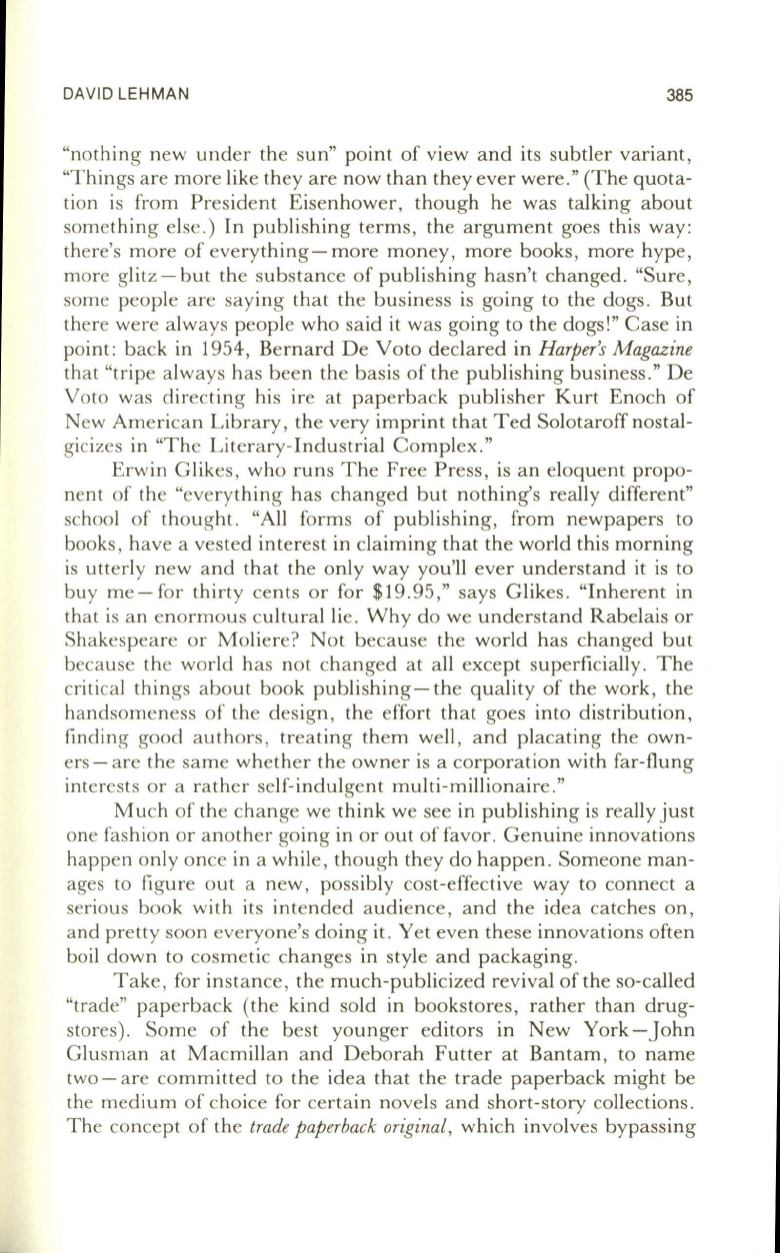
DAVID LEHMAN
385
"nothing new under the sun" point of view and its subtler variant,
"Things are more like they are now than they ever were." (The quota–
tion is from President Eisenhower, though he was talking about
something else.) In publishing terms, the argument goes this way:
there's more of eve rything- more money, more books, more hype,
more glitz - but the substance of publishing hasn't changed. "Sure,
some people a re saying that the business is going to the dogs . But
there were always people who said it was going to the dogs!" Case in
point: back in 1954, Bernard De Yoto declared in
Harper's Magazine
that "tripe always has been the basis of the publishing business ." De
Yoto was directing his ire at paperback publisher Kurt Enoch of
New American Library, the very imprint that Ted Solotaroff nostal–
gicizes in "The Literary-Industrial Complex."
Erwin Glikes, who runs The Free Press, is an eloquent propo–
nent of the "everything has changed but nothing's really different"
school of thought. "All forms of publishing, from newpapers to
books, have a vested interest in claiming that the world this morning
is utterly new and that the only way you'll ever understand it is to
buy me- for thirty cents or for $19.95," says Glikes . "Inherent in
that is an enormous cultural lie . Why do we understand Rabelais or
Shakespeare or Moliere? Not because the world has changed but
because the world has not changed at all except superficially. The
critical things about book publishing- the quality of the work, the
handsomeness of the design , the effort that goes into distribution,
finding good authors, treating them well, and placating the own–
ers - are the same whether the owner is a corporation with far-flung
interests or a rathe r self-indulgent multi-millionaire."
Much of the change we think we see in publishing is really just
one fashion or anot her going in or out of favor. Genuine innovations
happen on ly once in a while, though they do happen. Someone man–
ages to figure out a new, possibly cost-effective way to connect a
serious book with its intended audience, and the idea catches on,
and pretty soon eve ryone's doing it. Yet even these innovations often
boil down to cosmetic changes in style and packaging.
Take, for instance, the much-publicized revival of the so-called
"trade" paperback (the kind sold in bookstores, rather than drug–
stores). Some of the best younger editors in New York-John
Glusman at Macmillan and Deborah Futter at Bantam, to name
two - are committed to the idea that the trade paperback might be
the medium of choice for ce rtain novels and short-story collections.
The concept of the
trade paperback original,
which involves bypassing


